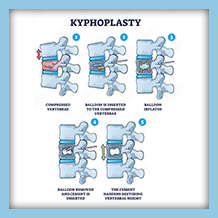

Kyphoplasty involves inserting a small balloon into the spine through an incision in the skin. Once inside the body, the balloon is inflated to push out the broken bone fragments and restore the height of the vertebrae. Kyphoplasty is usually performed in conjunction with another treatment, such as medication or physical therapy.
What is a Vertebral Compression Fracture?
The bones of your spine are called vertebrae. Vertebral compression fractures occur when vertebrae fracture and collapse. These fractures are often caused by osteoporotic bone loss, a condition that causes bones to become weak and brittle. When a vertebral body breaks, it can cause pain and other problems. If you have had a vertebral compression fracture, you may notice that you feel pain when you move. You may also notice that you have trouble sleeping because of the pain. Sometimes, a vertebral compression fracture will heal on its own. But if it doesn’t, you may need surgery to repair the problem.
A compression fracture occurs when there is a break in the vertebrae. This causes the bone to collapse and become shorter. As a result, the spine becomes curved forward and kyphotic. This results in difficulty walking, reaching for things, and conducting activities of daily living. Multiple compression fractures can also cause pain and discomfort.
Chronic low back pain, loss of mobility, diminished appetite, and trouble sleeping are all symptoms of a vertebral compression fracture. These symptoms may last for months or years. Patients with vertebral compression fractures are also at an increased risk of developing serious or even fatal pulmonary complications.
Who is a Candidate for Kyphoplasty Surgery?
These procedures can be useful for treating people who have weak bones because of cancer or osteoporosis.
Kyphoplasties and vertebroplasties are used to mend recent vertebral compression fractures. However, they’re not used as a preventive technique for osteoporosis, even for those at risk. They’re also usually not advised for herniation disk, back arthritis, or scoliosis. Kyphoplasty and vertebroplasties are often used to treat pain caused by bone loss.
These surgeries haven’t been tested in younger, otherwise healthy people. The long-term effects of the bone cement are not yet known, and these procedures are generally reserved for older patients.
Complications
Generally, kyphoplasty surgery goes as expected without any complications. However, like any other surgery, some complications could occur. In many cases, these are fairly minor. Complications of kyphoplasty can include:
- Numbness or weakness from nerve injury
- Movement or leakage of the cement
- Infection
- Bleeding
Your spine surgeon will discuss your personal health history to assess whether you are more at risk for certain complications.
What to Expect Before Kyphoplasty Surgery
Before your spine surgeon schedules the surgery, you’ll undergo a complete assessment, physical exam, and medical tests. This can include blood tests, X-rays, or an MRI. It is important that your surgeon knows exactly the specific location of the fracture and to evaluate its severity. For patients with severe pain that hasn’t gone away or improved with other treatment options, the surgeon may recommend kyphoplasty.
What to Expect During Kyphoplasty Surgery
Kyphoplasty involves inserting a balloon catheter into the body through a small incision at the site of the fracture. Once inside the body, the balloon is inflated to expand the bone and create a cavity. A mixture of bone cement and saline solution is then injected into the cavity. The bone cement hardens and strengthens the bone, while the saline solution helps prevent it from leaking out of the cavity.
Outcomes and Recovery Times After Kyphoplasty Surgery
Kyphoplasties deliver pain relief in as little time as 12 to 48 hours. Most patients experience a speedy recovery because it is a minimally-invasive procedure. Kyphoplasty is a successful treatment for vertebral compression fractures, which occur when bones become weak and brittle due to osteoporosis.
Kyphoplasty involves inserting a balloon-like device into the fractured bone. Once inserted, the balloon inflates and compresses the fracture, relieving pressure on nerves and blood vessels. Patients usually recover quickly and resume normal activities in a few weeks.
Get More Information About Kyphoplasty Surgery From the Experts at Orthopedic & Laser Spine Surgery
Kyphoplasty surgery can be extremely beneficial and successful for the patients that need it. For more information about kyphoplasty and to see if you’re a candidate, contact our team at Orthopedic & Laser Spine Surgery.
We have the experience and expertise needed to help you get the results and relief you deserve. You can schedule an appointment through our contact form or call our office at (855) 853-6542.
